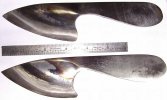There's not really any specific regular old barstock steel. Most likely what you see in fab shops and at Lowes is low carbon steel, maybe called weld steel. It isn't appropriate for knife making because of it's low carbon content.
It is important to know what specific steel you are using as this determines the appropriate heat treatment. Each steel has a specific heat treatment. Taking the regular old "back-yard" neo-tribal Rambo heat treatment and applying it across the board just doesn't work. Keep that in mind. If you don't know what the steel is, then you'll have to guess, experiment with your heat treatment, and try to find the best combo to harden the steel appropriately. It's just trial and error that way, so it's often recommended, to save time and effort and produce the best blade possible, to use known steel.
As for the original question, I still say you're doing O1 a big disservice by heat treating it inadequately. It has the potential to be a great knife steel if treated correctly. 1084 steel is better suited to torch heat treating. Like has been said, you'll probably get the O1 hard, and it may make a servicable knife, but it's not going to be at its best potential. So, use this type of experimentation as a learning experience. Try not to overheat the steel if you're using a fire pit. It's easy to burn the tip or thinner areas of the blade as you have no means to control the temperature in a coal fire without experience in how to manage it.
As for quench, edge fist, spine first, or tip first will work just fine for the most part. Just make sure you go in smoothly and evenly, and agitate tip-to-butt or spine-to-edge once it's in the oil. Agitate until vapors stop forming off the hot blade if you just lift the butt above the oil's surface. And if you're using off-the-shelf household oils like canola or the like, it should be pre-heated to around 130F or so. Leave the blade in the oil until it's oil temp and then take it out, wipe it off and file test it. Then straight into the tempering oven.
--nathan

